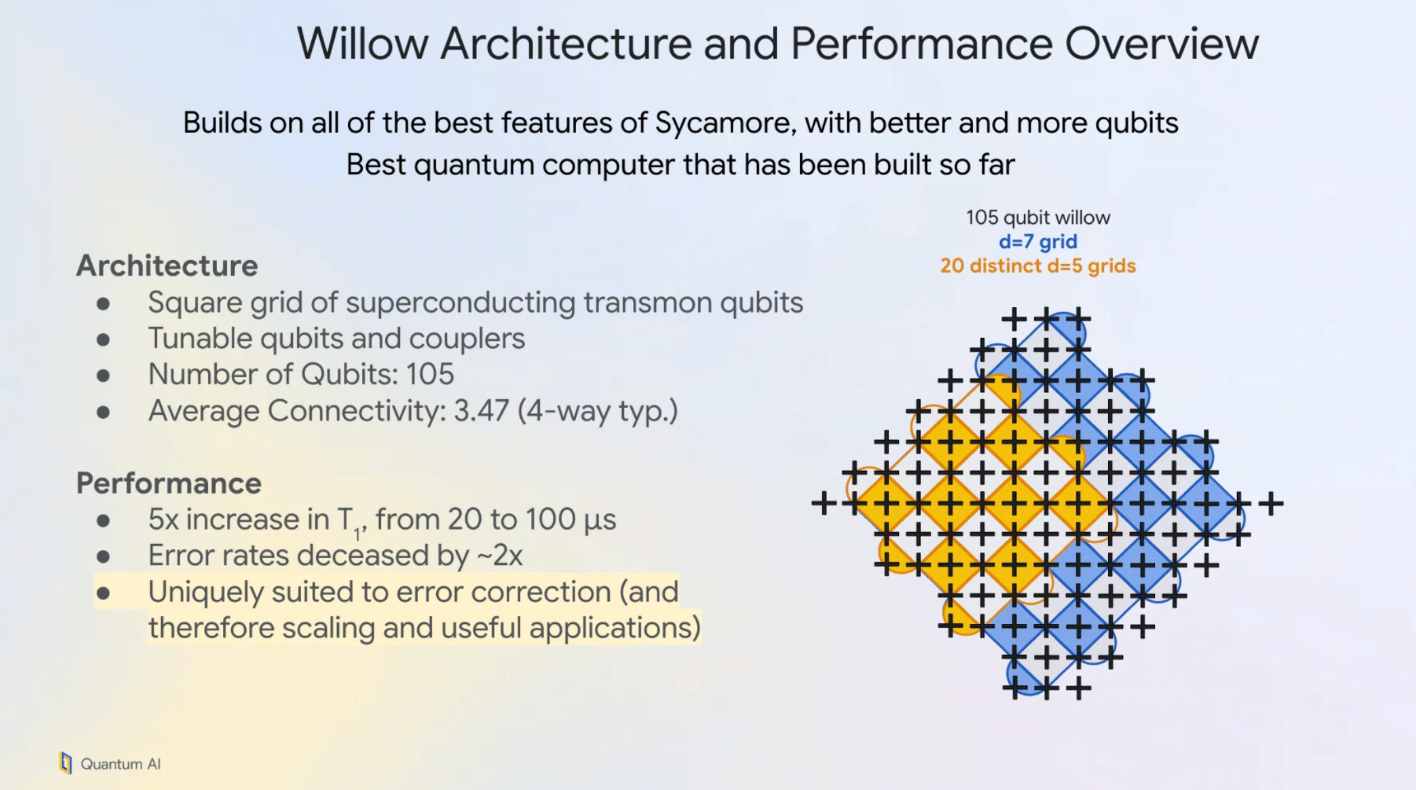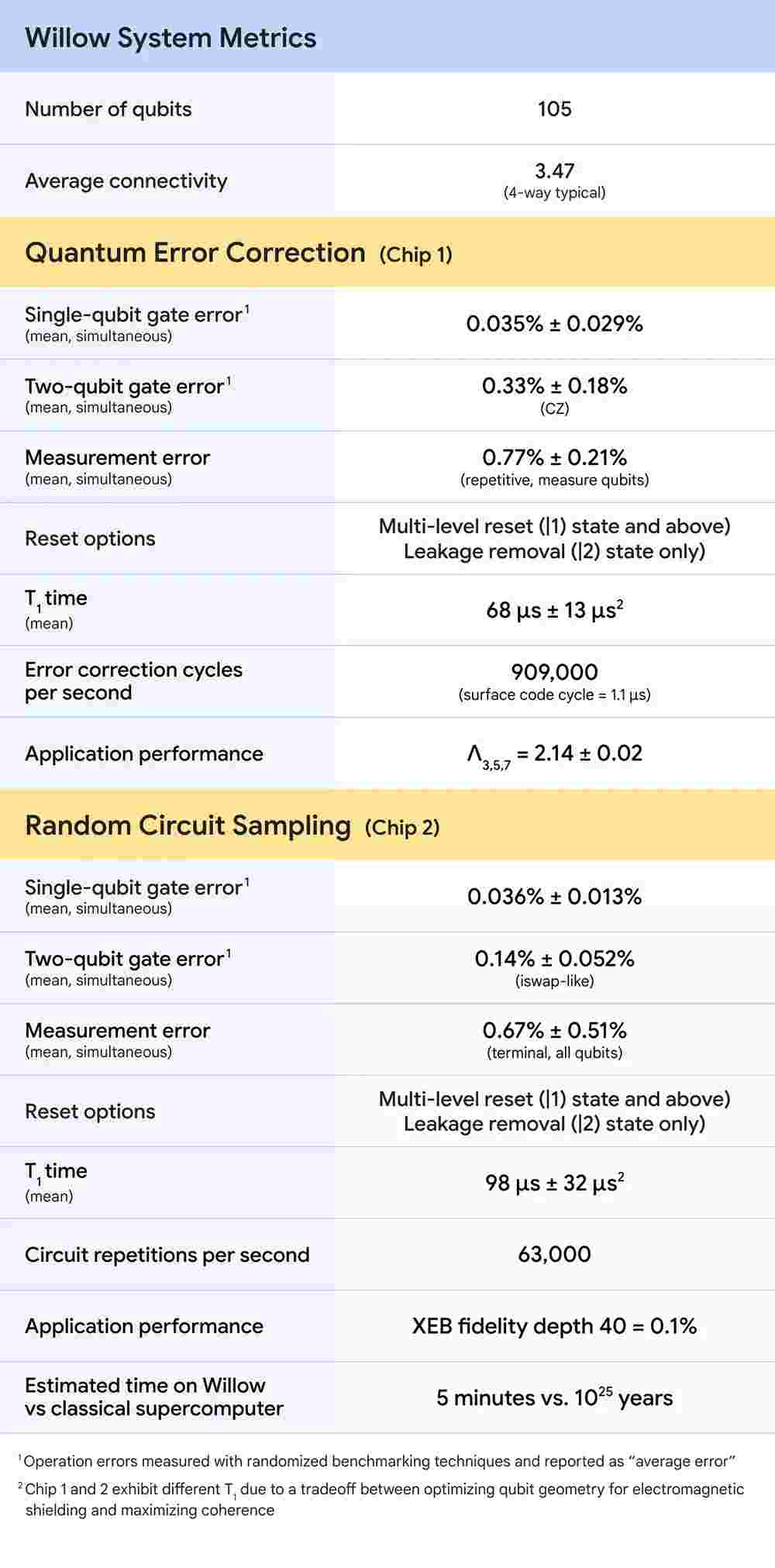The Google Willow Quantum Chip is a cutting-edge piece of technology that pushes the boundaries of computing.
Unlike traditional computers that rely on binary bits, the Willow chip uses quantum bits, or qubits, which allow it to perform calculations at an incredibly faster rate.
Quantum computing harnesses the power of quantum mechanics, enabling faster processing and solving complex problems that would take classical supercomputers years to compute.
Willow’s main feature is its ability to process vast amounts of data simultaneously through quantum entanglement and superposition. This allows the chip to outperform conventional computers in tasks such as optimisation, simulation, and cryptography.
With the Willow Quantum Chip, Google is making significant strides in the field of quantum computing, opening new doors for industries ranging from medicine to artificial intelligence.
This chip marks a major leap towards achieving the true potential of quantum technologies.
Also Read| Google for India 2024: Latest AI Features and Other Announcements
What is the Google Willow Quantum Chip? A Complete Overview
Google has recently unveiled its latest quantum computing chip, Willow, which represents a significant advancement in the field of quantum technology.
This state-of-the-art chip is designed to tackle complex computational problems at speeds unattainable by classical computers and even the fastest supercomputers.
Key Features of Willow
Qubit Count: Willow is equipped with 105 qubits, the fundamental units of quantum computation.
Unlike classical bits, which can only exist in one of two states (0 or 1), qubits can exist in multiple states simultaneously due to a phenomenon known as superposition.
This capability allows quantum computers to perform many calculations at once, greatly enhancing their processing power.
Error Correction: One of the most notable advancements with Willow is its enhanced error correction capabilities.
Traditionally, increasing the number of qubits in a quantum system leads to higher error rates due to environmental disturbances.
However, Willow employs innovative techniques that allow it to reduce error rates exponentially as more qubits are added, marking a critical breakthrough in quantum computing.
Performance Metrics

In benchmark tests, Willow demonstrated its extraordinary capabilities by solving a standard computational task in less than five minutes.
In stark contrast, this same task would take one of today’s most powerful supercomputers approximately 10 septillion years (or 1025 years) to complete—an unfathomably long time that exceeds the age of the universe.
This performance not only surpasses previous Google quantum processors, such as Sycamore, but also showcases the potential for practical applications in various fields like drug discovery and artificial intelligence.
Technological Innovations
Superconducting Qubits: Willow utilises superconducting transmon qubits, which are tiny electrical circuits that exhibit quantum behaviour at ultra-low temperatures.
Maintaining these qubits at temperatures just above absolute zero minimises disturbances that could lead to errors during computations.
Real-Time Error Correction: The chip's ability to correct errors in real time is crucial for making quantum computing viable for real-world applications.
This feature helps ensure that as computations become more complex with additional qubits, performance remains stable and reliable.
Implications for Quantum Computing
The introduction of Willow signifies a pivotal moment in quantum computing research and development. By overcoming significant challenges related to error rates and computational speed, Google positions itself at the forefront of a technological revolution that could transform industries reliant on complex data processing and problem-solving.
How Does the Google Willow Quantum Chip Work?
The Google Willow quantum chip represents a significant advancement in quantum computing technology, utilising innovative techniques to solve complex problems at unprecedented speeds. This section outlines the key mechanisms and principles behind how Willow operates.
Fundamental Principles of Quantum Computing
- Qubits: Unlike classical bits that represent either a 0 or a 1, qubits can exist in multiple states simultaneously due to superposition. This allows quantum computers to explore numerous possibilities at once, enhancing computational power significantly.
- Entanglement: Qubits can also be entangled, meaning the state of one qubit can depend on the state of another, even when separated by large distances. This property is crucial for performing complex calculations and transmitting information efficiently.
Design and Architecture
- Superconducting Transmon Qubits: Willow employs superconducting transmon qubits, which are tiny electrical circuits designed to exhibit quantum behaviour at extremely low temperatures. These circuits function like artificial atoms and are cooled to just above absolute zero to minimise environmental disturbances that could lead to errors in calculations.
- Improved Qubit Connectivity: The chip features enhanced connections between qubits, allowing for more complex and efficient quantum computations. This connectivity is essential for scaling up the number of qubits while maintaining performance.
Error Correction Mechanisms

One of the most significant challenges in quantum computing is managing errors that arise from environmental noise and instability in qubit states. Willow addresses this challenge through:
Exponential Error Reduction: Willow's architecture allows for an exponential reduction in error rates as more qubits are added. This capability is a breakthrough in quantum error correction that researchers have pursued for nearly three decades.
Real-Time Error Correction: The chip can correct errors in real time, which is critical for maintaining reliable computations as the system scales up. This feature ensures that even with a larger number of qubits, the overall performance remains stable and accurate.
What's Next| Google Doodle Celebrating Krishnakumar Kunnath
Implications for Future Applications
The advancements represented by Willow suggest significant implications for various fields, including:
- Artificial Intelligence: Enhanced computational capabilities could lead to breakthroughs in machine learning algorithms.
- Medicine: Quantum computing may facilitate drug discovery by simulating molecular interactions more efficiently.
- Energy Systems: Applications in battery chemistry and fusion energy research could benefit from improved computational models.
In Case You Missed| United States Elections 2024: Google Doodle Inspires Millions to Vote
Why is Google Willow Considered Faster Than a Supercomputer?
Google's Willow quantum chip is considered faster than contemporary supercomputers due to its remarkable ability to perform complex computations in an extraordinarily short time frame. Here are the key factors contributing to this distinction:
1. Speed of Computation
Willow completed a benchmark computational task in under five minutes. In contrast, the same task would take one of today's fastest supercomputers approximately 10 septillion years (or 1025 years) to solve.
This staggering difference highlights the immense speed advantage that quantum computing can offer over classical computing systems.
2. Qubit Technology
Willow utilises 105 qubits, which can exist in multiple states simultaneously due to the principles of quantum mechanics, specifically superposition.
This allows the chip to perform many calculations at once, significantly speeding up processing compared to classical bits that operate in binary (0 or 1) states.
3. Enhanced Error Correction
A critical advancement of Willow is its exponential error correction capability. Traditional quantum systems face challenges with error rates that increase as more qubits are added.
However, Willow's design allows it to reduce these error rates exponentially as it scales up, which is a significant breakthrough in quantum error correction that researchers have pursued for nearly three decades.
This improvement enables more reliable computations and supports the chip's ability to handle complex tasks effectively.
4. Benchmarking Against Classical Systems
Willow's performance was measured using the random circuit sampling (RCS) benchmark, a standard metric for evaluating quantum processors.
This benchmark is designed to assess whether a quantum computer can outperform classical systems on specific tasks, demonstrating that Willow not only meets but exceeds expectations compared to classical supercomputers.
5. Implications for Future Computing
The advancements represented by Willow suggest a transformative potential for practical applications across various fields, including artificial intelligence, drug discovery, and complex system simulations.
By overcoming significant barriers related to speed and error rates, Willow paves the way for large-scale quantum computers capable of solving problems that are currently infeasible for classical systems.
For You| Google Doodle Today: Google Doodle Celebrates Rise of the November's Half Moon Cycle
Comments
All Comments (0)
Join the conversation